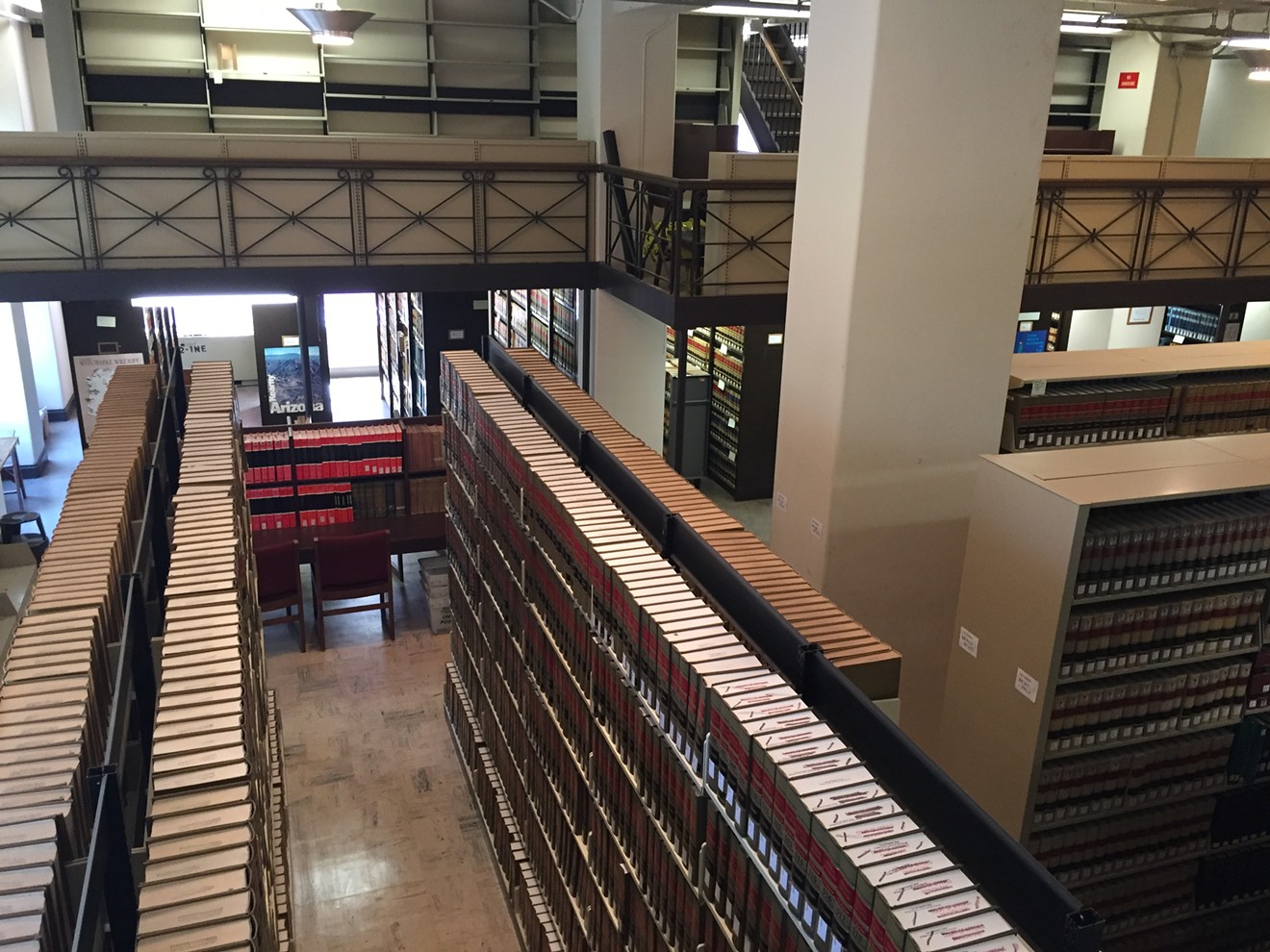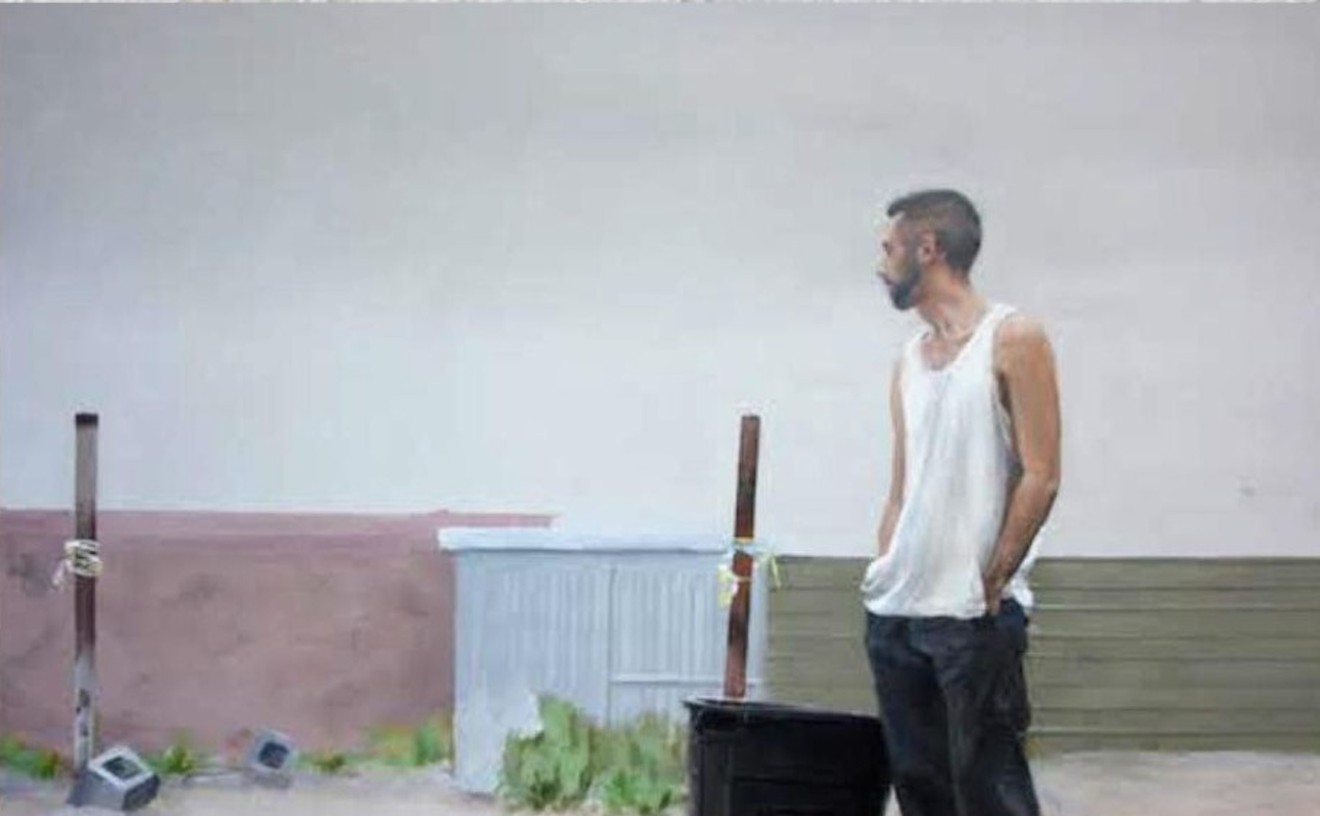"Let's go have some fun," says the guide at the start of a behind-the-scenes tour at the Research Library at the Arizona State Capitol in late June. This tour, and others like it, were a last chance to see the inner workings of the old 1938 library facilities, before the library moves to the Polly Rosenbaum Archives and History Building, 1901 West Madison Street.
The Research Library materials include the historic and current Arizona laws and regulations, complete federal depository, and the largest collection of state agency publications in Arizona. As of Monday, July 3, researchers, and the public seeking materials from the physical collections, will need to visit the reading room at the Polly Rosenbaum Archives and History building about four blocks away.
Matt Roberts, Director of Communications for the Arizona Secretary of State, puts the scale of this move in perspective. "We're in the middle of preparations to move about 25,000 linear feet of materials," he says.
Or, to put it another way, that's more than a million items, including legal materials, state publications, trademarks and patent resources, and federal documents.
As the tour begins approximately a dozen people, plus a few library staffers, work their way through a series of narrow and tight spaces, heading up and down stairwells, and watching their heads on low ceilings.
From the exterior, the Capitol appears to be a four-story building, but once inside the library stacks there are actually eight floors staggered as mezzanine levels inside. The maze of staircases and mezzanines house rows and rows of steel bookshelves. To help move all those books up and down, the building was outfitted with a series of dumbwaiters powered by a three-horsepower Otis.
These intermediate floors, with rows of shelving, function like an inner skeleton of the Capitol building. The mezzanine-leveled structure, built in 1938, speaks to how important and vital the library's role was.
So, why move?
For one, the Polly Rosenbaum building, completed in 2008, is climate-controlled. It is also handicap-accessible, which the current building is not.
Plus, it already houses the Arizona Archival Collections and the Genealogy and Family History resources, as well as photographs, maps, and newspapers. So when the State Library completes this move, the resources of the Arizona State Library, Archives & Public Records will be more centralized.
"Now, all of our research library staff will be under one roof," Roberts says, as opposed to stored in three separate buildings, as they were. In theory, this also will make customer service better.
It is a mountain of materials. Library staff anticipate that it will take more than a year to complete the move. In the meantime, Roberts says, "just because we're moving doesn't mean we can stop being responsive to requests."
Online material use will not be affected, but for those requesting physical legal resources, federal documents, and some state publications it may require a little extra time. The State Library is recommending appointments to ensure that materials are located and ready to be viewed upon arrival at the Polly Rosenbaum Reading Room. Researchers will also need to bring a photo I.D. for reading room access.
On the tour, someone says in amazement, "All of this is going to move?" The group laughs.
It's clear that Library Director Laura Stone, who's been tasked with the Herculean effort to oversee the move, has her work cut out for her. But it's also a fantastic opportunity to move materials to a more appropriate space.
Continuing down a corridor, we arrive at a pile of boxes recently transferred from the Arizona Department of Transportation. Having just closed its own library, the Department of Transportation materials have been transferred here, to the Research Library, where they will be processed and join the rest of the collection. We walk past a set of empty shelves where bills, introduced during the territorial days, have been sent to technical services for scanning. Shortly, they will be available online as part of the Arizona Memory Project.
Some fear the move means books will be going away. While it's true that the Research Library has been discarding non-Arizona legal materials (most of which are available online), "There's nothing that we're going to get rid of, once and for all, that there isn't a way for us to get our hands on," says Roberts.
The Reading Room located at the Capitol, which features a series of murals by artist Jay Datus, will be renovated once the move is complete and re-opened as Arizona Capitol Museum exhibition space. As for the mezzanine rooms and steel stacks inside the Capitol's, their fate is less clear.
The move consolidates the State Library of Arizona and Digital Arizona Library branches into the State of Arizona Research Library. More updates and information can be found at the Arizona Library website.
The Polly Rosenbaum Archives and History Building is open from 9 a.m. to 4 p.m. Monday through Friday. Call 602-926-3720.
[
{
"name": "Air - MediumRectangle - Inline Content - Mobile Display Size",
"component": "18478561",
"insertPoint": "2",
"requiredCountToDisplay": "2"
},{
"name": "Editor Picks",
"component": "16759093",
"insertPoint": "4",
"requiredCountToDisplay": "1"
},{
"name": "Inline Links",
"component": "17980324",
"insertPoint": "8th",
"startingPoint": 8,
"requiredCountToDisplay": "7",
"maxInsertions": 25
},{
"name": "Air - MediumRectangle - Combo - Inline Content",
"component": "16759092",
"insertPoint": "8th",
"startingPoint": 8,
"requiredCountToDisplay": "7",
"maxInsertions": 25
},{
"name": "Inline Links",
"component": "17980324",
"insertPoint": "8th",
"startingPoint": 12,
"requiredCountToDisplay": "11",
"maxInsertions": 24
},{
"name": "Air - Leaderboard Tower - Combo - Inline Content",
"component": "16759094",
"insertPoint": "8th",
"startingPoint": 12,
"requiredCountToDisplay": "11",
"maxInsertions": 24
}
]











